
Porcupinefish are medium-to-large fish belonging to the family Diodontidae from the order Tetraodontiformes which are also commonly called blowfish and, sometimes, balloonfish and globefish. They are sometimes collectively called pufferfish, not to be confused with the morphologically similar and closely related Tetraodontidae, which are more commonly given this name.

Cynognathus is an extinct genus of large-bodied cynodontian therapsids that lived in the Middle Triassic. It is known from a single species, Cynognathus crateronotus. Cynognathus was a predator closely related to mammals and had a southern hemispheric distribution. Fossils have so far been recovered from South Africa, Argentina, Antarctica, and Namibia.

Beaufort West is a town in the Western Cape province in South Africa. It is the largest town in the arid Great Karoo region, and is known as the "Capital of the Karoo". It forms part of the Beaufort West Local Municipality, with 34,085 inhabitants in 2011.

The striped burrfish or simply burrfish is a member of the porcupinefish family Diodontidae.
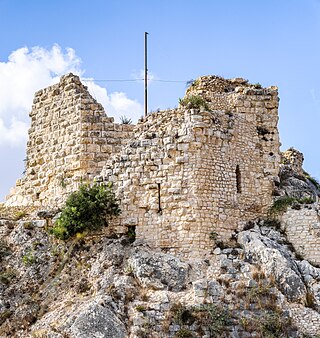
Beaufort or Belfort Castle, known locally as Qal'at al-Shaqif or Shaqif Arnun, is a Crusader fortress in Nabatieh Governorate, Southern Lebanon, about 1 kilometre (0.62 mi) to the south-south-east of the village of Arnoun. There was a fortification on the site before it was captured by Fulk, King of Jerusalem, in 1139 and construction of the Crusader castle probably began soon after. Saladin captured Beaufort in 1190, but 60 years later Crusaders re-took it. In 1268 Sultan Baibars finally captured the castle for the Islamic forces.
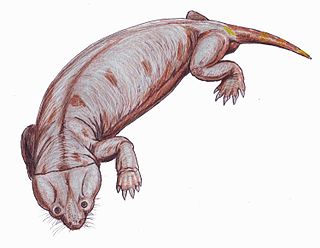
The Cistecephalus Assemblage Zone is a tetrapod assemblage zone or biozone found in the Adelaide Subgroup of the Beaufort Group, a majorly fossiliferous and geologically important geological group of the Karoo Supergroup in South Africa. This biozone has outcrops located in the Teekloof Formation north-west of Beaufort West in the Western Cape, in the upper Middleton and lower Balfour Formations respectively from Colesberg of the Northern Cape to east of Graaff-Reinet in the Eastern Cape. The Cistecephalus Assemblage Zone is one of eight biozones found in the Beaufort Group, and is considered to be Late Permian in age.
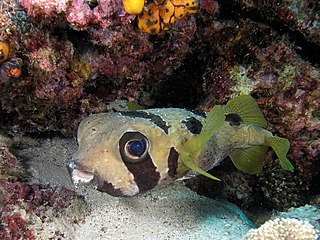
The black-blotched porcupinefish, also known as shortspine porcupinefish, is a member of the family Diodontidae. It is found in the tropical and subtropical waters of the Indo-Pacific on coral and rocky reefs and in inshore waters. Other names are the blotched porcupinefish and the brown-backed porcupinefish.

The spot-fin porcupinefish, also known as the spotted porcupinefish, black-spotted porcupinefish or simply porcupinefish, is a member of the family Diodontidae.

The long-spine porcupinefish, also known as the freckled porcupinefish among other vernacular names, is a species of marine fish in the family Diodontidae.

The slender-spined porcupine fish or globefish is a porcupinefish of the family Diodontidae, found in the waters of southern Australia, as far north as Port Jackson to Geraldton, Western Australia. It is most common in Port Phillip Bay and the coastal waters of Tasmania in shallow coastal waters and under manmade jetties. It is known to occur at a depth range of 1 to 70 m.
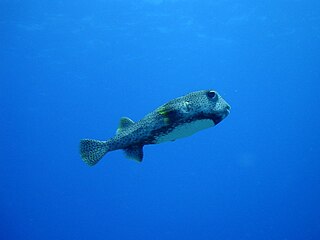
Porcupinefishes or balloonfishes, are any of the various species of the genus Diodon, the type genus of Diodontidae.

Beaufort's naked-backed fruit bat is a species of megabat in the family Pteropodidae. It roosts in caves.

Owenetta is an extinct genus of owenettid procolophonian parareptile. Fossils have been found from the Beaufort Group in the Karoo Basin of South Africa. Although most procolophonians lived during the Triassic, Owenetta existed during the Wuchiapingian and Changhsingian stages of the Late Permian as well as the early Induan stage of the Early Triassic. It is the type genus of the family Owenettidae, and can be distinguished from other related taxa in that the posterior portion of the supratemporal bears a lateral notch and that the pineal foramen is surrounded by a depressed parietal surface on the skull table.

Chilomycterus reticulatus, the spotfin burrfish, spotted burrfish, Pacific burrfish, spotfin porcupinefish or few-spined porcupinefish, is a species of fish in the genus Chilomycterus, which is part of the porcupinefish family Diodontidae.

Dicotylichthys punctulatus, also known as the three-bar porcupinefish, is a species of porcupinefish endemic to the east coast of Australia, where it is found in coastal and offshore reef environments down to 50 m (160 ft) deep. This species grows to 40 cm (16 in) in standard length, although most only reach 18 cm (7.1 in). This species is the only known member of the genus Dicotylichthys.
Lophodiodon calori, also known as the four-bar porcupinefish, is a species of porcupinefish native to the Indo-Pacific where it is found in environments with a substrate composed of rubble and sand at depths of at most 100 metres (330 ft), often above the continental shelf. Although adults of the species are benthic in nature, juveniles are pelagic. It feeds on hard-shelled invertebrates and is noted to be an uncommon species. The species grows to a length of 30 centimetres (12 in) SL and is the only known member of its genus.

Lieven Ferdinand de Beaufort was a Dutch biologist who, in 1903, participated in the North New Guinea Expedition. In the 1920s he was director of the Zoological Museum of Artis in Amsterdam and later zoogeography professor at the University of Amsterdam.

Cyclichthys orbicularis, known commonly as the birdbeak burrfish among other vernacular names, is a species of marine fish in the family Diodontidae.
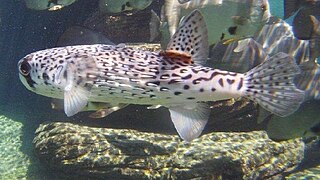
Diodon eydouxii, commonly known as the pelagic porcupinefish, is a species of porcupinefish with a circumtropical marine distribution.
Aspistor hardenbergi is a species of sea catfish in the family Ariidae. It was described by Patricia J. Kailola in 2000, originally under the genus Arius. It inhabits tropical marine and brackish waters in southern New Guinea. It reaches a maximum standard length of 25.4 cm (10.0 in).
















